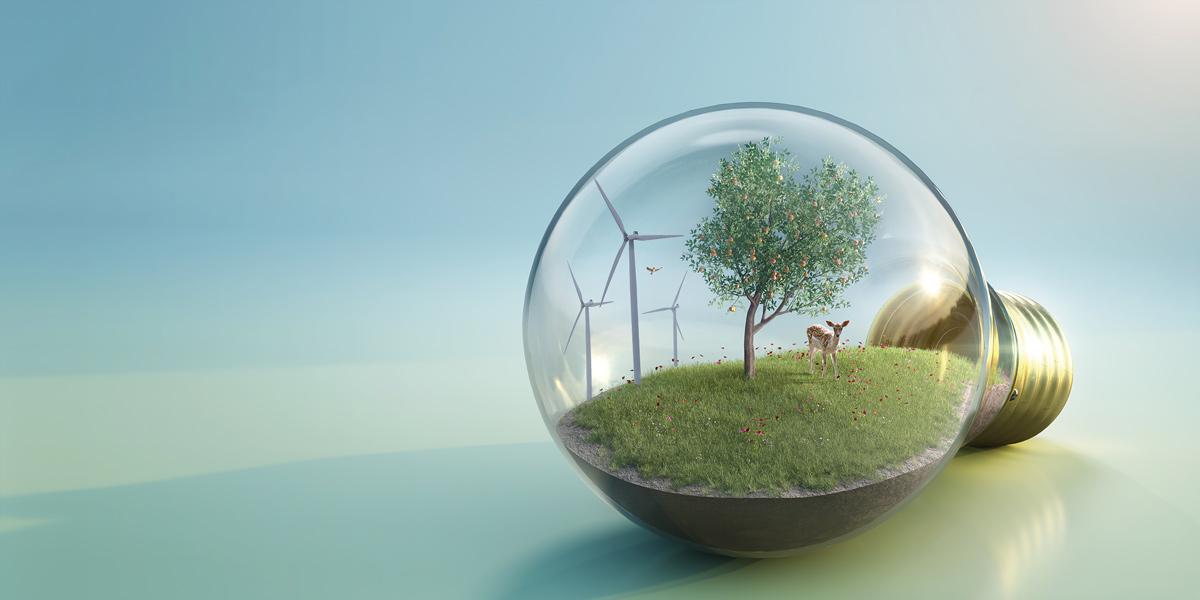
MEETING
Global Challenges
TOGETHER

MEETING
Global Challenges
TOGETHER
BY EMILY MATCHAR
Food. Water. Energy.
Three basic needs. But getting these necessities to the right places, at the right times, in the right amounts, without harming people or the environment, is a monumental task. And some of the conditions of modern life — climate change, war, pandemics — have made it even more difficult.
Researchers in the College of Agriculture and across Purdue are responding to the issues of climate, food, water and energy security from different angles. Increasingly, they’re doing it together, using a variety of interdisciplinary frameworks to enhance innovation, because an interconnected world needs interconnected solutions.
Analyzing climate challenges from every angle
To Tom Hertel, our main task for the future is both simple and daunting: “Feeding the world while protecting the environment.”
Hertel is a distinguished professor of agricultural economics and founder and executive director of the Global Trade Analysis Project (GTAP), a network of more than 26,000 researchers in nearly every country on earth. GTAP maintains databases and models on international economic policy, which can be used for a multitude of research purposes, including examining climate and food issues.
Achieving sustainable food and water supplies is, by necessity, an interdisciplinary project, Hertel says. Take this example: an ecologist is working on the impacts of converting natural lands to farming, an entomologist is researching the reduction in pollinators and an economist is analyzing the global food trade. These three people are studying interrelated phenomena: environmental degradation diminishes pollinator populations, which makes agriculture less productive, which requires more cropland and results in disruptions to global food chains.
Hertel’s current passion project is all about connections. Called GLASSNET (Global to Local Analysis of Systems Sustainability, a Network of networks), it’s funded by the National Science Foundation to build networks of people working on global food, water and environmental challenges across disciplinary and national boundaries.
“We’re doing global economic analysis over here; they’re doing global ecological analysis over there,” Hertel says. “We need to be brought together. That's the mission.”
Across campus, Matt Huber, a climate scientist and co-principal investigator on the GLASSNET project with Hertel and other economists, leads another interdisciplinary initiative.
Huber is professor of earth, atmospheric and planetary sciences and director of Purdue’s new Institute for a Sustainable Future (ISF). ISF addresses global sustainability by integrating climate, environment and food-energy-water security work.
“We’re thinking about how can we best take the amazing scientists, researchers, extension outreach people — everybody at Purdue — and help them do their sustainability-related science better,” he says. “As a scientist, when I envision the future, I run a climate model. But that’s not the only way to conceptualize the future. What’s the role of literature? What’s the role of art? What’s the role of politics?”
Huber’s own area of interest is the warming of already-warm regions. While a lot of talk about climate change focuses on melting ice caps, Huber looks at what happens when the temperature near the equator goes up. The stakes are high, since 70 percent of the world’s biodiversity is in the tropics, and 50 percent of the human population is in the tropics and subtropics.
“People are thinking that heat waves will become more extreme, and that’s true,” he says. “But they are also going to be longer, to the point where, if you’re in the tropics and subtropics, a heat wave will be three months long.”
Extended heat waves will be dangerous, because without air-conditioning, people will die of heat stroke. Yet air-conditioning generates greenhouse gases that will further warm the planet, creating the sort of conundrum best addressed by collaboration.
Extreme heat waves would also destabilize global trade and food security. “If you have to work in the fields picking cacao, but it’s too hot to do that, where is the food going to come from?” Huber asks.
To calculate exactly how each degree of rising heat would change the world, Huber works with economists like Hertel.
“We provide heat stress [data] and they calculate all the economic effects,” he says. “It’s a pretty breathtaking model. My agricultural economics colleagues are truly amazing.”
Keeping food stocked and the environment healthy
The early pandemic food shortages — no eggs one day, no flour the next — followed by the 2022 infant formula shortage made many Americans acutely aware of the complexities of supply chains. Those supply chains involve innumerable factors, like the fuel that powers the tractors, the health of farm workers, USDA regulations on egg packaging, the cost of plastic and the weather in Florida. A change to any one of those factors can disrupt supply chains. A break in the baby food supply chain left shelves bare, infants hungry and parents terrified.
Jayson Lusk, former head of the Department of Agricultural Economics, was the founding director of the Center for Food Demand Analysis and Sustainability (CFDAS), which explores economic issues that drive or increase food insecurity. He believes understanding these issues could help avoid some of the catastrophes of the recent past. The center uses the monthly Consumer Food Insights Survey to track in near–real time how consumers are experiencing food security or insecurity.
One surprising result of the survey is that recent food price inflation doesn’t yet seem to have caused a general increase in food insecurity in the United States. CFDAS analysts hypothesize that this is due to increased pandemic savings as well as increased government support programs.
But as states pull back on things like SNAP benefits (Supplemental Nutrition Assistance Program), food insecurity will likely start to increase, Lusk says.
Collecting data like this can help provide insights that increase food supply resiliency. Increased resiliency means that supply chains are less likely to be disrupted and, when they are, more quickly repaired with less impact on consumers.
For example, incentivizing more small and medium suppliers to enter the market might increase resiliency in the meat sector. Their products might be more expensive because smaller suppliers lose some efficiencies, but the overall supply would be more stable than a system with only a few large suppliers.
Understanding this complicated web of factors involves multiple disciplines, Lusk says. “We can help create economic models, but we need people in agronomy, soil sciences and engineering.”
Michael Langemeier approaches food security issues from a different angle. Langemeier, professor of agricultural economics and associate director of the Center for Commercial Agriculture, studies how precision agriculture might help stabilize the food supply and decrease energy needs.
“How can we increase production given we don’t have a lot of land that’s going to be available going forward?” he asks. “That’s a real challenge.”
The key, he says, will be increasing productivity and yield without creating negative consequences like water pollution. In precision agriculture, information technology is used to make farm management decisions at smaller scales. This can improve not only yields, but also environmental outcomes, Langemeier says. “You’re not going to apply herbicide on an acre that’s not needed; you’re going to apply it only where it’s needed,” he says. “That’s an absolutely huge advancement.”

How can we increase production given we don’t have a lot of land that’s going to be available going forward? That’s a real challenge.
— Michael Langemeier, professor of agricultural economics and associate director of the Center for Commercial Agriculture
How can we increase production given we don’t have a lot of land that’s going to be available going forward? That’s a real challenge.
— Michael Langemeier, professor of agricultural economics and associate director of the Center for Commercial Agriculture
Precision agriculture requires engineers to develop new technologies, extension experts to help disseminate information about them, agricultural economists to quantify the benefits and so on.
And there’s another complication: Farmers can’t use precision technologies that require an internet connection if they don’t have high-speed access. According to Langemeier’s research, about one-third of farmers have poor or limited internet access. Improving access requires a new area of interdisciplinary work, bringing in politicians and other policymakers.
Fueling our food
You can’t have food without energy. That’s where Farzad Taheripour comes in. Taheripour, research professor of agricultural economics and member of GTAP, is interested in how to maintain a stable energy supply in the short term while reducing greenhouse gas emissions in the long term.
He admits this is challenging. “We are facing inflation, challenges in the energy market, the attack of Russia against Ukraine and instability in the crude oil market.”
But a stable energy supply is crucial for a stable supply of everything else, from food to water to medical necessities. “In order to produce food, we need to farm it first, and for products like corn or soybeans, about 40 to 50 percent of the cost of the production is energy,” Taheripour says. “This means when we have higher energy prices, automatically we may see higher food prices at the same time. We need to look at the interaction of these markets.” Higher fuel costs can also affect everything from worker pay to shipping times.
Tackling fuel issues is more interdisciplinary than you might think, Taheripour says. For example, when should we use land for farming versus for solar panels? It’s a complex calculation that requires input from agronomists, atmospheric scientists, energy economists, farmers and others.
“My message is to look at the whole problem as a system,” Taheripour says. “Don’t just look at one side or one angle of this story.”
Working together for a stable, sustainable food supply
All these issues — food, water, fuel, climate — come together at the Purdue Center for Global Food Security (PCGFS). While the center has been around for more than a decade, the pandemic disrupted many of its programs. Under its new director, Sylvie Brouder, professor of agronomy and Wickersham Chair of Excellence in Agricultural Research, the PCGFS is being revitalized this year.
Brouder’s background as an ecologist gives her a broad view on issues of food security, says Gebisa Ejeta, distinguished professor of plant breeding and genetics, the center’s executive director, and Purdue University Presidential Fellow for Food Security and Sustainable Global Development.
“One of the dogmas of ecology is that this planet we live on is not just important to man but also important to beasts, to all of the flora and fauna it sustains,” Ejeta says.
In other words: The food supply needs to be not only stable but also sustainable for everyone and everything. From a long list of both short- and long-term challenges, PCGFS plans to focus on three areas. The first is developing and implementing food security technologies, from simple food storage bags to keep pests out of grain to onboard computers for farm machinery. The second is creating programs linking agriculture, nutrition and health. The third is adapting to and mitigating the effects of climate change on agriculture and the food supply. Projects could include developing more heat-resilient crops, building cooling stations for agricultural workers or increasing yields in shrinking patches of productive land.
For these projects, PCGFS aims to draw researchers and stakeholders from across the university and the broader community, holding town hall meetings to share ideas and generate new ones. Brouder hopes to help reenergize cross-departmental collaborations. “People miss the experience of collegial science for purpose,” she says.
Huber makes a similar point: “Through COVID-19, I think a lot of people have become isolated, and bringing people together is always a good idea. We’re trying to get everybody together again, talking.”
All three PCGFS focus areas capitalize on the center's experience in multidisciplinary approaches and national and international projects. In 2017, for example, PCGFS helped start the African Center of Excellence for Climate Smart Agriculture and Biodiversity Conservation at Haramaya University in Ethiopia. Huber, the climate scientist and director of ISF, traveled there with Ejeta. At Haramaya, he co-advised a PhD student growing different varieties of food crops to see which ones could thrive in hotter, drier climates. “That was a really exciting project to be involved with,” Huber says.
In places like Ethiopia, which doesn’t significantly contribute to climate change, yet will bear the brunt of it, adaptations like these will be key to survival, he says. Brouder and Ejeta agree that building capacity in places hardest hit by climate change will be crucial to future security.
In addition to climate change, major issues affecting global food security include war, disease, supply chain stresses and — perhaps most frustratingly — government policies. The pandemic caused many governments in developed countries to turn inward, Brouder and Ejeta say. Worried about their own food and vaccine supply, they suddenly doubted the value of globalization. Aid programs to desperately hungry countries took a back seat. “Everyone went into themselves and forgot that we live on one planet, globally shared,” Ejeta says.
The pandemic taught us that national borders don't apply in the spread of infectious disease. These Purdue experts say the same is true of food security, climate change, water resources and energy access.
“Wherever we live in the world, we’re part of a complex ecosystem,” Brouder says. “We have a responsibility to each other.”

- Researchers in the College of Agriculture and across Purdue are collaborating to address the issues of climate, food, water and energy security.
- The Global Trade Analysis Project, founded by agricultural economist Tom Hertel, maintains databases and models on international economic policy that help examine climate and food issues.
- The Global to Local Analysis of Systems Sustainability Network brings together researchers working on global food, water and environmental challenges.
- Agriculture faculty are also members of the Institute for a Sustainable Future, which integrates environmental and climate analysis with research on food, water and energy security.
- The Center for Food Demand Analysis and Sustainability, founded by agricultural economist Jayson Lusk, releases the monthly Consumer Food Insights Survey to track food demand, satisfaction and security.
- Understanding economic issues that drive or increase food insecurity can help avoid or mitigate disruptions in the food supply chain.
- Precision agriculture can also help stabilize the food supply and decrease energy needs, but it requires new technologies, information dissemination and high-speed internet access.
- Managing energy use and costs is also essential to a stable food supply, but requires expertise from farmers, agronomists, atmospheric scientists and energy economists.
- The Purdue Center for Global Food Security, led by agronomists Sylvie Brouder and Gebisa Ejeta, supports a stable but sustainable food supply by concentrating on technology; the links between agriculture, nutrition and health; and adapting to and mitigating the effects of climate change.

